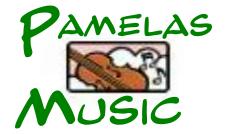| Violin parts |
| Pegs: Wooden string tuners
usually made of ebony or rosewood. Early violins often had boxwood pegs. |
| Fingerboard. Attached to the
neck of the violin . Made of ebony. |
| Scroll. The finial of the
violin at the peg box. Sometimes old violins have a carved head instead. |
| Table or belly.
The curved
top with f shaped sound holes. |
| Neck. |
| Ribs. The sides
of the violin body between the table and back. |
| Bridge. Rests
between the f holes supporting the strings and transmits the sound to the
table. |
| sound post. A
short dowel of wood to take the vibration of sound from the belly to the
back. Wedged inside near the foot of the bridge. E string side. |
| Bass bar.
A strengthening support under the belly from the fingerboard end towards
the tailpiece |
| Tuning. G.D.A.E |
| Curl, flame: The
figuring on the woods used. |
| Neck graft.
Early violins Pre early 19th century (no set date) had slightly shorter
necks and a flatter neck angle with tapered fingerboards. To update
instruments to modern specification violins were given new necks. The
original peg box and scroll was cut and grafted onto the new neck. |
| Tail piece. A nearly triangular piece of ebony
(or other) where the string ends a held. Secured by a tail gut (often
nylon now) to the end pin . |
| End pin. A wooden peg at the end of the violin
to hold the tail gut. |
| Nut. A slightly slotted piece of ebony ( or
bone/ ivory on some) at the end of the fingerboard adjoining the peg box
to locate the strings. |
| Fiddle: Now
generally same as a violin, usually a style of playing, although early
instruments were known as fiddle a generic term of various bowed
varieties. |
|
History: The violin is a stringed instrument,
that produces sound
using a body and a vibration of strings, with a range of about
three octaves. The idea of the violin
first evolved in the Orient and in Turkey. It was adapted to
European tasted around in the fifteenth and sixteenth centuries,
and introduced by Italy to Iran and the Middle East. The violin we
play today is a natural ancestor of the Rebec, the Baroque guitar
and the Lira da braccio, three stringed instruments of old Europe.
There were many precursors to the violin. Some, such as the
Ravanstron,
the Rabab and the Rebec have been around since 5000 B.C. There are several
others whose names are not known, also dating back to a few thousand B.C. |


